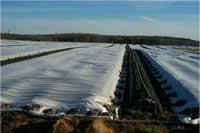Regional Adaptation and Yields
go.ncsu.edu/readext?185246
en Español / em Português
El inglés es el idioma de control de esta página. En la medida en que haya algún conflicto entre la traducción al inglés y la traducción, el inglés prevalece.
Al hacer clic en el enlace de traducción se activa un servicio de traducción gratuito para convertir la página al español. Al igual que con cualquier traducción por Internet, la conversión no es sensible al contexto y puede que no traduzca el texto en su significado original. NC State Extension no garantiza la exactitud del texto traducido. Por favor, tenga en cuenta que algunas aplicaciones y/o servicios pueden no funcionar como se espera cuando se traducen.
Português
Inglês é o idioma de controle desta página. Na medida que haja algum conflito entre o texto original em Inglês e a tradução, o Inglês prevalece.
Ao clicar no link de tradução, um serviço gratuito de tradução será ativado para converter a página para o Português. Como em qualquer tradução pela internet, a conversão não é sensivel ao contexto e pode não ocorrer a tradução para o significado orginal. O serviço de Extensão da Carolina do Norte (NC State Extension) não garante a exatidão do texto traduzido. Por favor, observe que algumas funções ou serviços podem não funcionar como esperado após a tradução.
English
English is the controlling language of this page. To the extent there is any conflict between the English text and the translation, English controls.
Clicking on the translation link activates a free translation service to convert the page to Spanish. As with any Internet translation, the conversion is not context-sensitive and may not translate the text to its original meaning. NC State Extension does not guarantee the accuracy of the translated text. Please note that some applications and/or services may not function as expected when translated.
Collapse ▲The annual plasticulture strawberry system is recommended for all regions of North Carolina, including the mountains; however the climate differences across the regions result in varied yields. Yields for mountain production are typically in the range of 1 to 1.2 pounds per plant, though ideal conditions have occasionally produced yields as high as 1.5 pounds per plant. Due to the shorter growing season in the fall and colder winters, this region of the state sees lower yields compared to the Piedmont and coastal plains where yields of 1.5 pounds per plant are regularly achieved with good management.
Plant spacing is another factor that contributes to yield per acre. Assuming that a given region has a typical yield of 1 pound per plant, the number of plants per acre (as determined by plant spacing) will directly affect the yield per acre. One acre will require 17,500 plants at 12-inch, double-row spacing, with bed centers five feet apart. Consequently, this one acre can yield 17,500 pounds of marketable berries. (See Table 1). As plant spacing increases, yield per acre (and therefore profit potential) decreases. Currently, however, many growers are utilizing 14-inch spacing for ease of picking. Less experienced pickers, tend to overlook the berries in the row middles and wider spacing makes those berries more visible.
Keep in mind also that not all varieties are equally productive. Chandler and Camarosa are the most productive varieties to grow followed by Sweet Charlie which is about one-third lower in yield.
Table 1. Marketable yield per plant and per acre for Chandler (pounds)1
|
Yield per plant |
12-inch spacing 17,500 plants/A2 |
14-inch spacing 15,000 plants/A |
15-inch spacing 14,000 plants/A |
|---|---|---|---|
|
1.0 |
17,500 |
15,000 |
14,000 |
|
1.5 |
26,250 |
22,500 |
21,000 |
1 Growers can expect slightly higher yields per plant with greater in-row spacings of 14- and 15-inches, but for preliminary planning purposes, it is fair to assume equal plant productivity at 12-, 14- and 15-inches.
2 Calculation based on in-row spacing assuming a double row with bed centers five feet apart.



